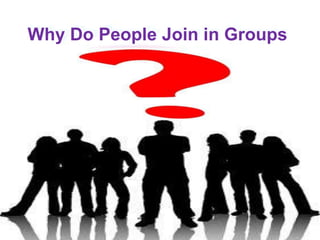
Why do people join in groups
- 1. Why Do People Join in Groups
- 2. What is a Group Two or more people who interact with one another, are aware of one another, and think of themselves as being a group. A collection of individuals who have regular contact and frequent interaction, mutual influence, common feeling of camaraderie, and who work together to achieve a common set of goals. K 2
- 3. Reasons for Joining a Group Closeness--Being members of the same group builds ties among people. Common goals--Moral and practical support is gained by working with others who have the same or similar goals. Achievement of personal objectives--Time spent with group members can be enjoyable, enhance a person’s prestige, and satisfy people’s desire to feel important. Accomplishment--accomplishing things as part of a group that they could not accomplish on their own. K 3
- 4. Groups in the Workplace Functional groups--fulfill ongoing needs in the organization by carrying out a particular function. Task groups--set up to carry out a specific activity, and they disband when that activity has been completed Formal groups--Groups set up by management to meet organizational objectives Informal groups--Groups that form when individuals in the organization develop relationships to meet personal needs K 4
- 5. What makes Group Cohesiveness Roles--Patterns of behavior related to employees’ positions in a group. Norms--Group standards for appropriate or acceptable behavior. Status--A group member’s position in relation to others in the group. Cohesiveness--The degree to which group members stick together. Homogeneity--The degree to which the members of a group are the same. K 5
- 6. Benefits Of Joining a Group Increased productivity and performance: A broader range of skills can be applied to practical activities and sharing and discussing ideas can play a pivotal role in deepening your understanding. Skills development: being part of a group will help you develop your interpersonal skills such as speaking and listening as well as team working. Knowing more about yourself: collaborating with others will help identify your own strengths and weaknesses. (for example, you may be a better leader than listener, or you might be good at coming up with the 'big ideas' but not so good at putting them into action). K 6
- 7. Social needs-- Determine whether people are likely to be satisfied with individual jobs or work groups Growth Needs--Affect whether people will be satisfied by traditional work designs or by enriched, self-regulating forms of work After all We know “United we stand- Divided we fall” and is well proved. Benefits Of Joining a Group Continued… K 7
- 8. K 8
